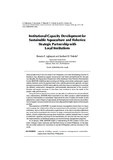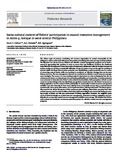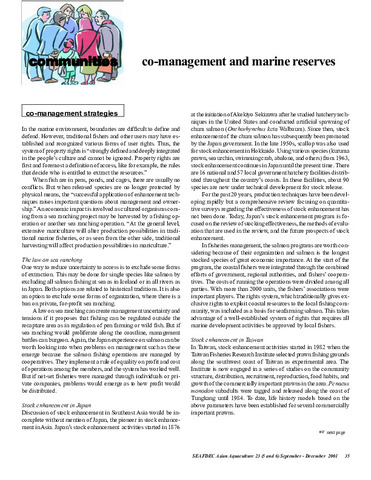Perlihatkan publikasi sederhana
Development and conservation of Philippine mangroves: institutional issues
| dc.contributor.author | Primavera, Jurgenne | |
| dc.date.accessioned | 2014-01-13T05:53:11Z | |
| dc.date.available | 2014-01-13T05:53:11Z | |
| dc.date.issued | 2000 | |
| dc.identifier.citation | Primavera, J. H. (2000). Development and conservation of Philippine mangroves: institutional issues. Ecological Economics, 35(1), 91-106. | en |
| dc.identifier.issn | 0921-8009 | |
| dc.identifier.uri | http://hdl.handle.net/10862/1880 | |
| dc.description | Special Issue: The Value of Wetlands: Landscape and Institutional Perspective. | en |
| dc.description.abstract | The decline of Philippine mangroves from half a million hectares in 1918 to only 120 000 ha in 1994 may be traced to local exploitation for fuelwood and conversion to agriculture, salt beds, industry and settlements. But brackishwater pond culture, whose history is intertwined with that of mangroves, remains the major cause of loss. The paper discusses the institutional issues — aquaculture as development strategy, low economic rent of mangroves, overlapping bureaucracy and conflicting policies, corruption, weak law enforcement and lack of political will — relevant to this decline. Recommended policies are based on these institutional factors and the experiences in mangrove rehabilitation including community-based efforts and government programs such as the 1984 Central Visayas Regional Project. These recommendations include conservation of remaining mangroves, rehabilitation of degraded sites including abandoned ponds, mangrove-friendly aquaculture, community-based and integrated coastal area management, and provision of tenurial instruments. | en |
| dc.language.iso | en | en |
| dc.publisher | Elsevier | en |
| dc.subject | Philippines | en |
| dc.title | Development and conservation of Philippine mangroves: institutional issues | en |
| dc.type | Article | en |
| dc.identifier.doi | 10.1016/S0921-8009(00)00170-1 | |
| dc.citation.volume | 35 | |
| dc.citation.issue | 1 | |
| dc.citation.spage | 91 | |
| dc.citation.epage | 106 | |
| dc.citation.journalTitle | Ecological Economics | en |
| seafdecaqd.library.callnumber | VF SJ 0656 | |
| seafdecaqd.databank.controlnumber | 2000-22 | |
| dc.subject.asfa | aquaculture development | en |
| dc.subject.asfa | ponds | en |
| dc.subject.asfa | coastal zone management | en |
| dc.subject.asfa | environmental impact | en |
| dc.subject.asfa | anthropogenic changes | en |
| dc.subject.asfa | mangrove swamps | en |
| dc.subject.asfa | nature conservation | en |
| dc.subject.asfa | policies | en |
| dc.subject.asfa | aquaculture | en |
| local.subject | Aquaculture | en |
| local.subject | Brackishwater ponds | en |
| local.subject | Community-based management | en |
| local.subject | Integrated coastal area/zone management | en |
| local.subject | Tenurial/property rights | en |
Files in this item
| Files | Size | Format | View |
|---|---|---|---|
|
There are no files associated with this item. |
|||
Publikasi ini ada di koleksi berikut
-
Journal Articles [1256]
These papers were contributed by Department staff to various national and international journals.



